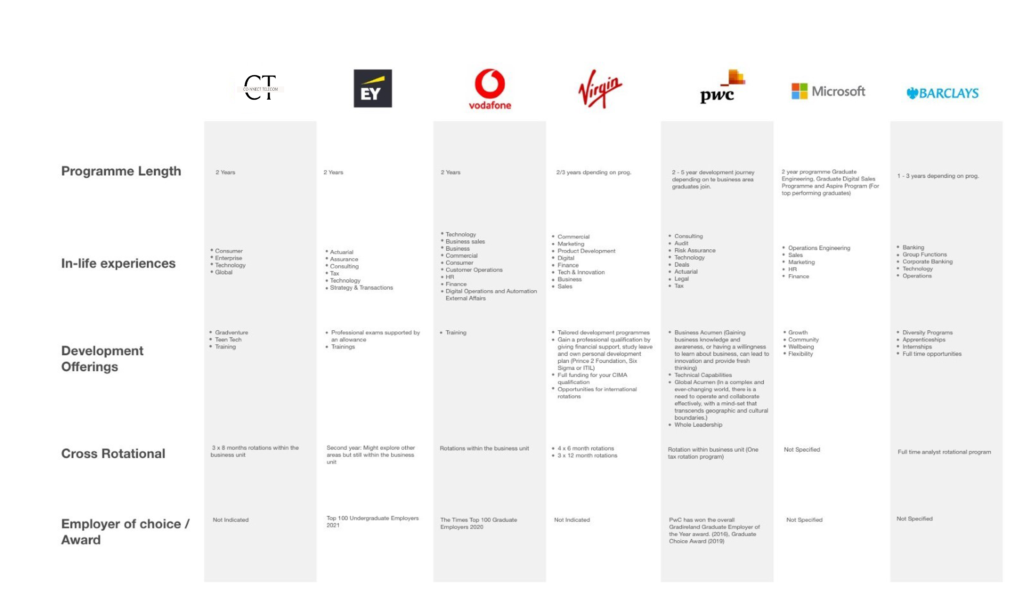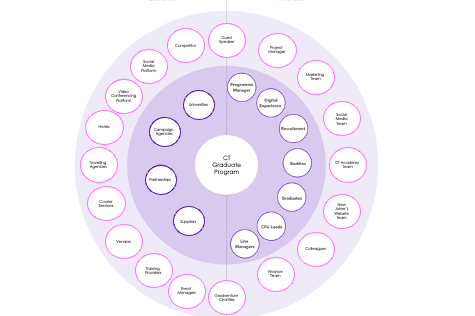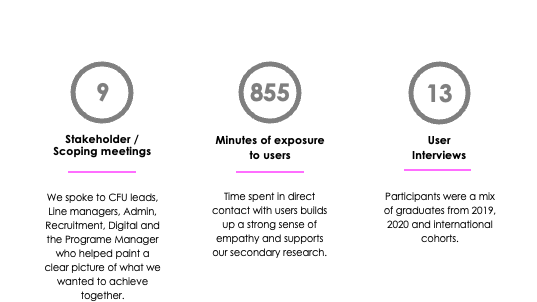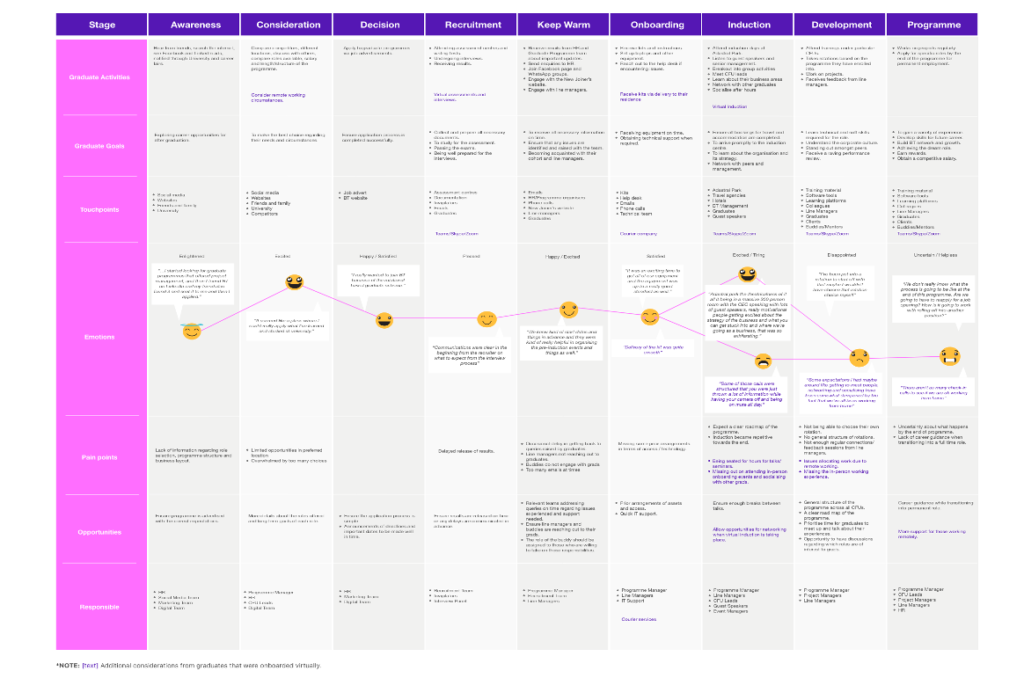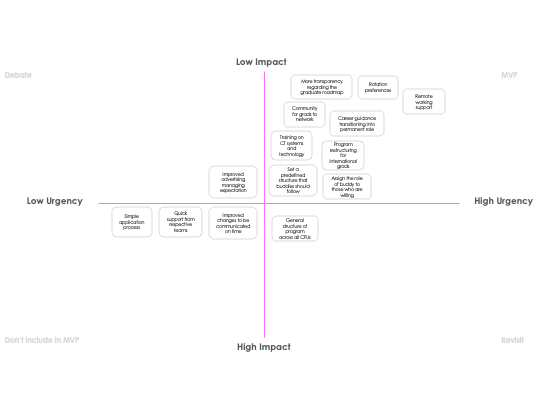
Exploring the onboarding experience of fresh recruits for Co-nnect telecom’s graduate program.
PROJECT SCOPE
Client- Co-nnect Telecom
Timeframe- 5 weeks
My role-UX Researcher
Team- Me along with a UX Consultant and Studio lead
Methods- Generative Research, Journey Maps, Personas (Should I also add interviews over here??)
Tools- Mural,Adobe XD, Teams, Word Speech to text tool
Project Overview
![]() CLIENT KICKOFF
CLIENT KICKOFF
CT believes in providing a seamless and hassle-free onboarding experience to the fresh recruits for their Graduate program and with the changing working environments after Covid,and therefore they wanted to enhance the virtual onboarding experience of the new Graduate cohort joining them. Under digital colleague Experience program CT wanted us to help them with understanding the experience of these Graduates while onboarding and discover their expectations of the programme.
![]() OBJECTIVES
OBJECTIVES
- Finding and exploring about the experience of current graduates onboarding (What worked well, which stage needs any improvement, graduate’s pains, gains and other potential opportunities)
- Investigating how graduates feel about the program, the curriculum, opportunities and rotation.
![]() NOTES
NOTES
CT offers a huge range of opportunities for school-leavers and graduates in different domains under their graduate programs.
At the time of this project, client was expecting the arrival off 2021-22 batch in the coming few months and they wanted to understand the overall experience of previous graduates with respect to company’s onboarding process. 2020-21 was the first batch for which virtual onboarding was done due to covid.
Methodology
Competitive Analysis
Stakeholder interviews
Graduate interviews
Affinity Diagram
Data Analysis
 Competitive Analysis
Competitive Analysis
Competitive Analysis Finding
- Programme length– CT’s length and rotational structure of the programme was found to be similar to most other companies of a duration of approximately 2 years.
- Development offerings– CT lacks providing opportunities for financial assistance regarding further qualifications.
- Awards -No indication of awards achieved with respect to the graduate programmes covered by CT.
 Stakeholder and Graduate Interviews
Stakeholder and Graduate Interviews
- Stakeholder Mapping- We did this to see major influencers involved in building and delivering Graduate program and at what capacity .
- Screener – For stakeholder interviews we selected a diverse group of individuals who were involved in delivering and running the graduate programme (CFU leads, line manager, admin), and for Graduate interviews we selected participants who were from a mix of graduates from 2019,2020 and international cohort.
- Remote moderation- Conducted these interviews online using teams.These were 45-60 min conversations with stakeholders and graduate to cover topics/questions of interest. The key benefit of choosing the semi-structured method is that conversation can naturally flow, there is an opportunity to explore in depth topics of interest as well as creating a more comfortable space for the participant to open up.
The Process
- We covered 9 stakeholder,13 user inteviews and dwelved intro around 855 minutes of exposure in this interaction.
- Since we were a team of two, we distributed the interviews amongst us. While taking the interview we recorded the interviews with users consent so as to have a reference for notes later.
- We created an interview script for our reference.
 Affinity Diagram
Affinity Diagram
We started with analyzing the major themes generated from the interviews. We categorised these themes, gave them title and started putting the insights generated under respective categories. This helped us in systematically grouping the insights under bigger themes.
The Process
- We started with putting up the transcripts from the interviews into mural and arranged the data into different colour codes (quotes, pain points, recommendations). Repeated same excercise for all the interviews taken.
- Next we found out major themes generating from the interview data. We categorized these themes, gave them title and started moving the insights generated under respective categories. This helped us in systematically grouping the insights under bigger themes.
- This exercise was conducted for stakeholder as well as graduate interviews. And after discovering themes across multiple interviews, we worked together to synthesize the data and agree on insights.
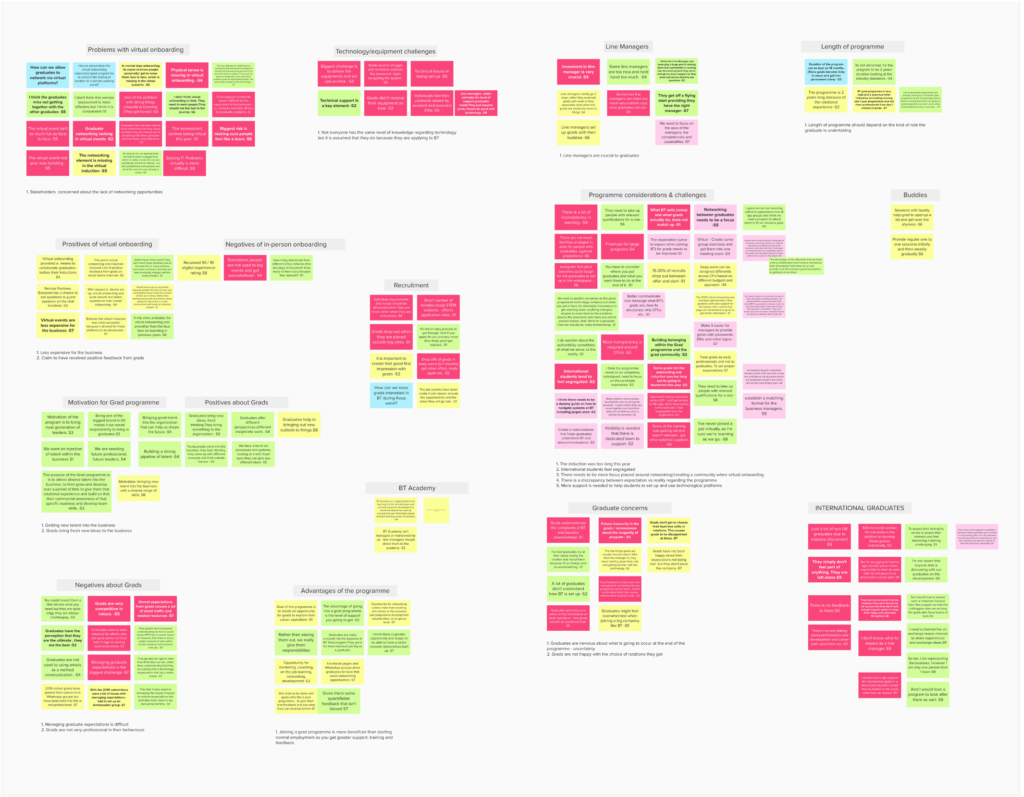
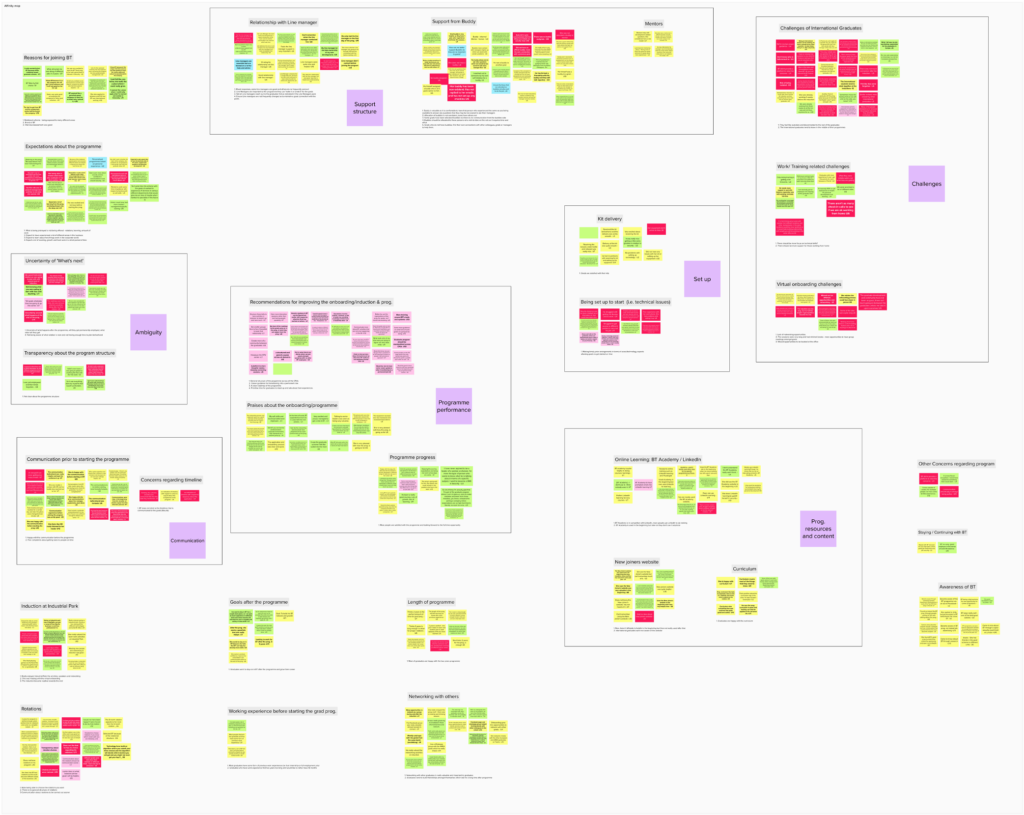
 Data Analysis
Data Analysis
INSIGHTS ON CT’S GRADUATE PROGRAMME
Reasons for joining CT’s Graduate Programme
- Rotational structure of the programme.
- CT being a big & well-known brand across the globe.
Expectations about the programme
- Discrepancy between what was being portrayed & what was being offered by CT.
- Expectation management is problematic for stakeholders.
Dealing with ambiguity
- Uncertainty concerning the end of the programme, role availability & rotations.
- Lack of transparency regarding programme structure.
Communication about the programme
- Graduates are generally satisfied with communications.
- Promptness of feedback can be improved.
Rotations
- Expectations to choose own rotations
- Lack of rotation structure
- Short notice of rotation selection
Previous work experience and length of programme
- Many graduates have previous work experience.
- Programme might be too slow or too long for these grads.
The importance of networking
- Graduate value networking & seek out opportunities to connect.
- Virtual induction lacked networking opportunities.
Programme performance
- Satisfied about programme’s curriculum, organisation, professionalism, support & learning potentiality.
- Improvements recommended regarding structure, career guidance, clearer roadmap & navigating the business.
Getting set up
- Satisfied with kit quality & prompt arrival.
- Ample time requested to fix technical issues beforehand.
- Training required for new CT technology & systems.
Relationships with line manager
- Mixed responses regarding helpfulness of line managers.
- Line managers crucial influencing grad’s perspective regarding the programme.
Allocation of Buddies
- No consistency in who gets a buddy allocated to them.
- Ensure that those selected as buddies should be willing to help.
Programme resources and content
- CT Academy seen as valuable at start of programme but is eventually replaced with LinkedIn Learning.
- New Joiner’s website accessed mainly before starting programme.
INSIGHTS RELATED TO ONBOARDING
International graduate’s challenges
- Feel like outsiders and disconnected with the rest of the graduates .
- Lack of support .
- Tend to leave programme early.
Working remote concerns
- More support required for graduates who are working from home and were onboarded virtually.
- Regular wellness checks suggested.
Virtual onboarding challenges
- Lack of networking opportunities for virtual onboarding
- Feeling of missing out
- Sessions were too long
 Personas
Personas
We made personas to help us to create an understanding and empathy with the end users. Thanks to personas – It helped us gain a perspective similar to the user. Here we have created 3 different types of personas with respect to an international candidate, a graduate from 2019 batch and a graduate from 2020 batch, who joined through virtual onboarding.
Bridgette is a 23-year-old and has joined CT as a marketing graduate in 2019.Bridgette always wanted to work in London and is quite excited to work across different brands. She is happy with the progress she has made through the programme but often feels that it would be nice if the programme provides her the flexibility to choose her rotations.
Natalia is 25 years old and is working as a Business management graduate. She belongs to Switzerland and has joined CT as an international candidate. She is more than excited to be part of CT and believes that CT has provided a strong foundation to her corporate career. But having said that she does sometimes feel isolated and disconnected from the rest of the team.
Daniel is 27 years old and is working as a software security graduate, he joined CT in 2020 through virtual onboarding. He is thoroughly enjoying the programme and aims to become a specialist in his work area someday. Going back to his onboarding days Daniel wishes that it would have been great if he have had a chance to attend in- person onboarding and could experience the same.
 Journey Map
Journey Map
The user journey map helped us in providing a clear understanding of how users are experiencing the service, what their goals are at each stage and what pain points they are experiencing at these stages. We clubbed the journeys of graduates who onboarded the program virtually with the graduates who had in-person onboarding in the same map. The purple text refers to the additional considerations from graduates who were onboarded virtually..
- We started the journey map by breaking down the whole programme into stages (which are indicated at the top in the purple boxes) which shows the journey a user will go through when joining the programme.
- On the left we have a pink bar which indicates some important user attributes like graduate activities, their goals, touchpoints, painpoints, emotions etc. The journey map helps in evaluating graduate’s emotions across every attribute while going through different stages of the programme.
- Also, we can clearly see here the emotion graph going downwards from the induction stage till the end of programme, which suggests that there might be some improvements required over to enhance user’s experience throughout the 3 stages.
 Problem Statements and How Might We
Problem Statements and How Might We
Bridgette, a marketing graduate, needs a clear roadmap of the graduate programme and transparency around the rotation structure because she wants to plan, manage her expectations and feel certain about her career progress but she can’t choose her rotation and is uncertain about what to expect by the end of the programme.
How might we… provide graduates with more transparency regarding the graduate roadmap?
How might we… help graduates’ voices to be heard regarding their rotation preferences?
How might we… assist graduates to make informed decisions regarding their career goals?
Prioritisation Matrix
We chose to conduct prioritisation matrix exercise to understand the urgency and needs of issues to be addressed in their particular order.
 Recommendations
Recommendations
- Conducting ideation workshop- Ideation workshops to explore and generate some broad set of ideas to improve the gaps discovered in the current onboarding process with a set of stakeholders and get their inputs/thoughts on same.
- Creating concepts- Concept testing to improve the onboarding experience of graduates.
- User testing
- Iterating low fidelity prototypes
 Reflection
Reflection
Industry Takeaway
The need to improve an existing system is the need to change times and the client believed in this theory. Keeping users in the center they focused on how to evolve their experience and make things smoother for them, which is a commendable thought. New graduates entering the company were given prior importance through this project, which showed how much they cared for their employees.
Personal Takeaway
It would be interesting to know if the insights helped in improving next year batch’s onboarding process. We were told to also explore about CT academy but later scope of the project was restricted to onboarding process.

